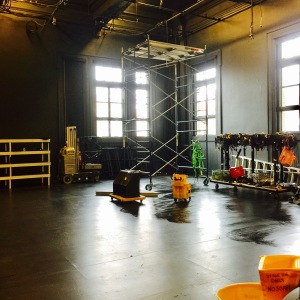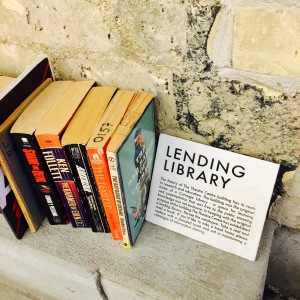The most consistent thing about the theatre centre is the consistency. Aislinn Rose
On our last field trip of this term, we went to the Theatre Centre on Queen West and met with the team. The core is made up of Franco Boni, the general and artistic director, general manager Aislinn Rose, manager of artist and community activation Myung-Sun Kim, technical Director Tim Lindsay, director of facilities and production Billy Wolf and last but not least, the director of development and partnership Christine Pellerin.

The interview took place in the small gathering space outside of the theatre–we had the chance to see the space in action with all the lights down for loading and reconfiguring the whole performing space inside the theatre. Exciting!
We open the discussion with each of their day-to-day responsibility and the general manager Aislinn gave us an overview of the theatre centre’s mandate and operation.The theatre centre isn’t like other theatre company that operate on a season basis(clock-work-like!) where theatre choose a number of places and performs between certain dates, and as each play comes along, you’ll hire producers and actors, do audition, get the creative team on board, show open and show close. Theatre company doesn’t work that way and in fact, it doesn’t have a season. Their schedule is often based around the artist they have in residence because their LTR(Long-Term Residency) program of development for the idea of production is that the number one thing they do as an organization which means their timeline is also based on the artist’s availability and timeline. The residency program has a minimum requirement of 2 years but often those residencies’ work would not necessarily be ready by the end of the second year. What they usually do it to extend the period until they’re ready for production. Sometimes they would come to a year which none of the project is mature enough to be presented whereas in the 2018-2019, they have 3 projects coming out at the same time. In contrast, on a quieter year without any major production such as 17-18, Theatre Centre has to focus on smaller things that’s on a short-term basis. Partnerships and possible collaboration are what they go after next. One question bubbled up in my mind while they’re talking about their side projects–I wonder how they implement a project in that sense because I always got so personally attach to the project I’m working with at the moment, and if something is designed to happen over a short period of time and that time only, I wonder if they grief over every one of them? Or do they just all become some arts organization buddhas?

I really admire the respect they have for the
artists. Aislinn kept emphasizing that their schedule is on the artist’s time. The way they are willing to extend the residency as long as the artists need while they’re here to facilitate and never put up a work before its ready to be
produced. They provide the space ad time(also financial and tech support) for artists to go through the learning curve and make mistakes without meandering. It’s an unique program in a way that it help nurture the artists and honour the artist process.

She mentioned some of the constant battles that they’re still fighting- how to bring in more audience and historic funding challenges with CCA and OAC. If you compare theatre centre to organizations in a relative size such asFactory Theatre and Buddies in Bad Times Theatre, theatre company is 200,000-250,000 short on operating budget from public funders. Their current operating budget is 900,000, but they should really be at the amount of 1.25 million for all the programs they have. However, theatre company has been stuck at its current funding level for eight years because funding usually works in a historical way and also there’s no new money coming in. Theatre company has to supplement that gap through private fundraising.
Christine, the director of development and partnership has been trying really hard to raise much more money through foundations, corporate and sponsorships. What they have achieved in the past three years are pretty significant for an organization in this size. For instance, the incubator downstairs is sponsored by BMO as part of the major capital gift but also essentially the key sponsor to its residency program. Humber college’s acting program was woking out of the incubator space which we didn’t get to see the space that day. Significance contribution was given every year directly into operating budget in support of its on-going programming and initiatives. In addition, theres also TD GreenRoof and the Streetcar Development Terrace that have naming rights over a particular space of the building.

One possible good new to this situation is that the Canada Council for the Arts has announced and is in the process of revamping of their fun
ding model by taking away the discipline-specific silos as well as a doubled-budget federal funding over the next few years by the new liberal government.


Glad to hear you liked the trip, Ching! Do you see any drawbacks regarding the LTR program? I agree that their respect for the artists and the artistic process is very admirable!
LikeLike
I for sure admire the resources and patience they pour into the LTR program. Still, I wonder if they have any mechanism or metric that would help determine the viability of their projects? I agree with honouring and respecting the artist process, however, does that mean there’s really no limit regarding the timeline? As I supposed that not every single project would make it to the finish line, how do they dictate if a project/artist/collective is inherently flawed or even a ‘death march’ or does every project deserve an equal opportunity?
LikeLiked by 1 person
Eight years for the same funding amount must be a huge challenge to the company since the price is raising up every single year. Did she mentioned anything about what they do to overcome the struggle besides bring in the private donations? Private donations are great, but not predictable. Sorry I left early that day for a meeting. Thanks in advance.
LikeLike
Hi Annie, could you please clarify a little more about the rising price every year? Do you mean by the property and building itself or the operating cost of running the programs? Since I couldn’t find their annual report on the website, I went on CRA and checked their registered charity’s return. Much to my surprise, in the 2016-2017 fiscal year, 26% of of their revenue came from government funding, 15% from donations and gift, which left 60% listed under ‘other revenue.’ As I delve deeper into their detailed financial information, I figured that the ‘other revenue’ were made up of investment interests, sales and amortization of deferred capital contributions. What do you think is the implication behind the given information and why? I admit that it’s a bit odd considering how much I enjoyed reading financial statements. But I just couldn’t held back my curiosity!
LikeLike
This is so interesting for me to read because i did not get the chance to be on this trip! I had no idea that they were on a show by show basis, i think that makes the environment a lot more fast paced and exciting because it means that there are constantly new things happening in the theatre! I think that private fundraising, although it might be difficult, might actually be a good idea considering thats a great way to cultivate and create new relationships.
LikeLike
Totally! And also according to their donor board, they’ve been pretty successful soliciting support for their capital campaign with naming sponsor including TD, BMO and Streetcar Developments.
LikeLiked by 1 person
Hey Ching! This was very interesting, especially the part about how the Theatre Centre have had the same funding for eight years, that must be very tough. Since we’re in the Fundraising class this semester, I’m wondering if it’s their written proposal or budget that the CCA and OAC don’t see eye to eye with. From a funder’s perspective, I can see how Theatre Centre not having a conventional yearly schedule/season of programming would affect its success in receiving grants.
LikeLike
Agreed! I couldn’t wait to see how the new CCA funding model plays out and hopefully it would help the theatre centre with the financial shortfall.
LikeLike
I agree, I adore the LTR concept. I believe this makes the Theatre Centre very unique in its programming. I think Myung-Sun is the perfect person as their community activation manager because she is able to creativly respond to the needs of the organziation by brainstorming new programming to continue engaging the theatre’s community no matter what stage the LTR work is at. It is an incredibly risky move on their part but, it seems to be doing well.
LikeLike
I remember Shannon’s article “Choreograph the future” mentioned that both Britain and Australia began to use this kind of funding model several years ago. It’s an irreversible trend and imperative I believe. As long as the CCA has a receptacle in place to receive feedback from the grant applicants and take quick actions to improve. I believe soon in the future the revamped model will be a beloved mechanism, but the premise is the doubled funding of course!
LikeLike